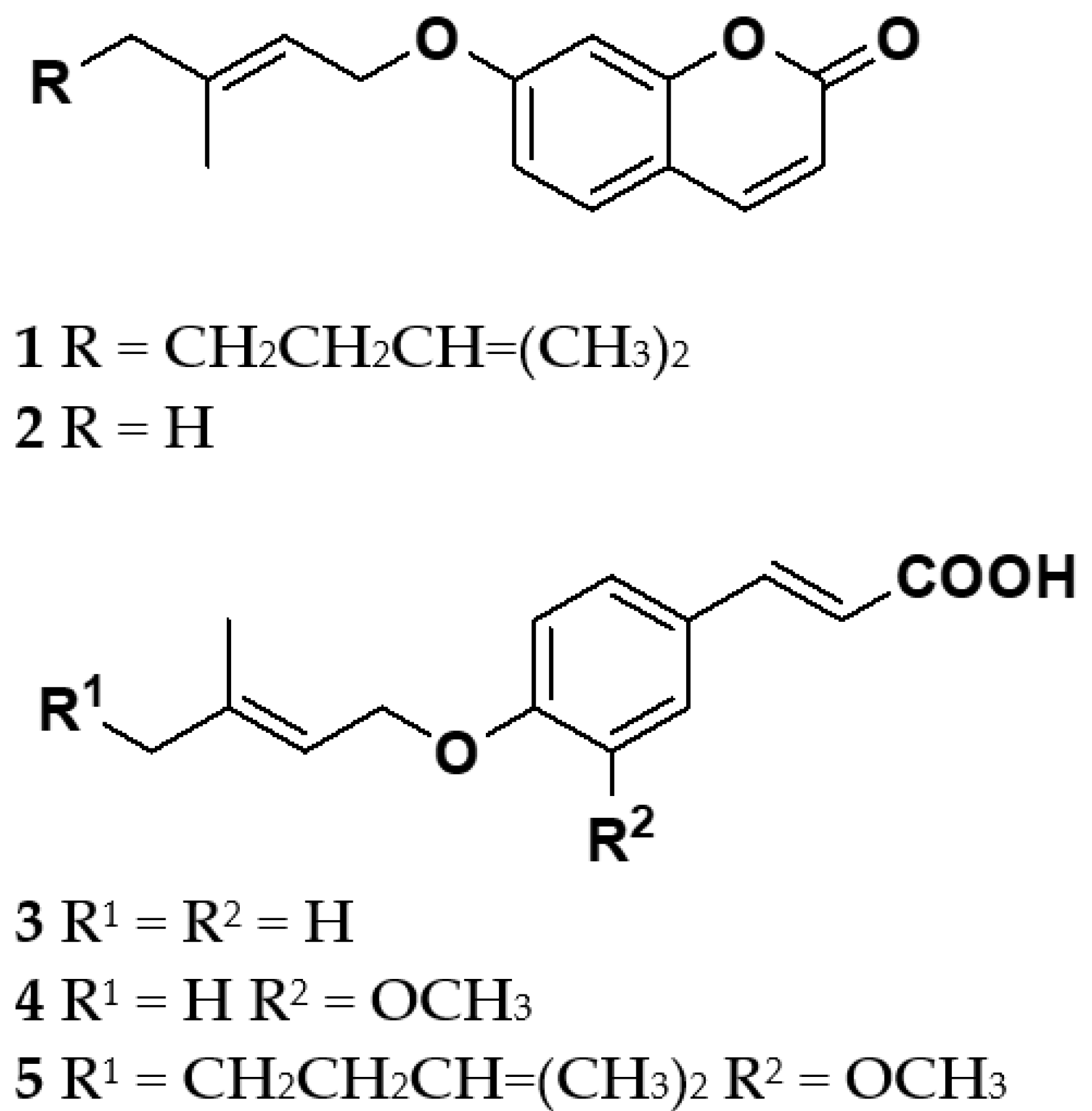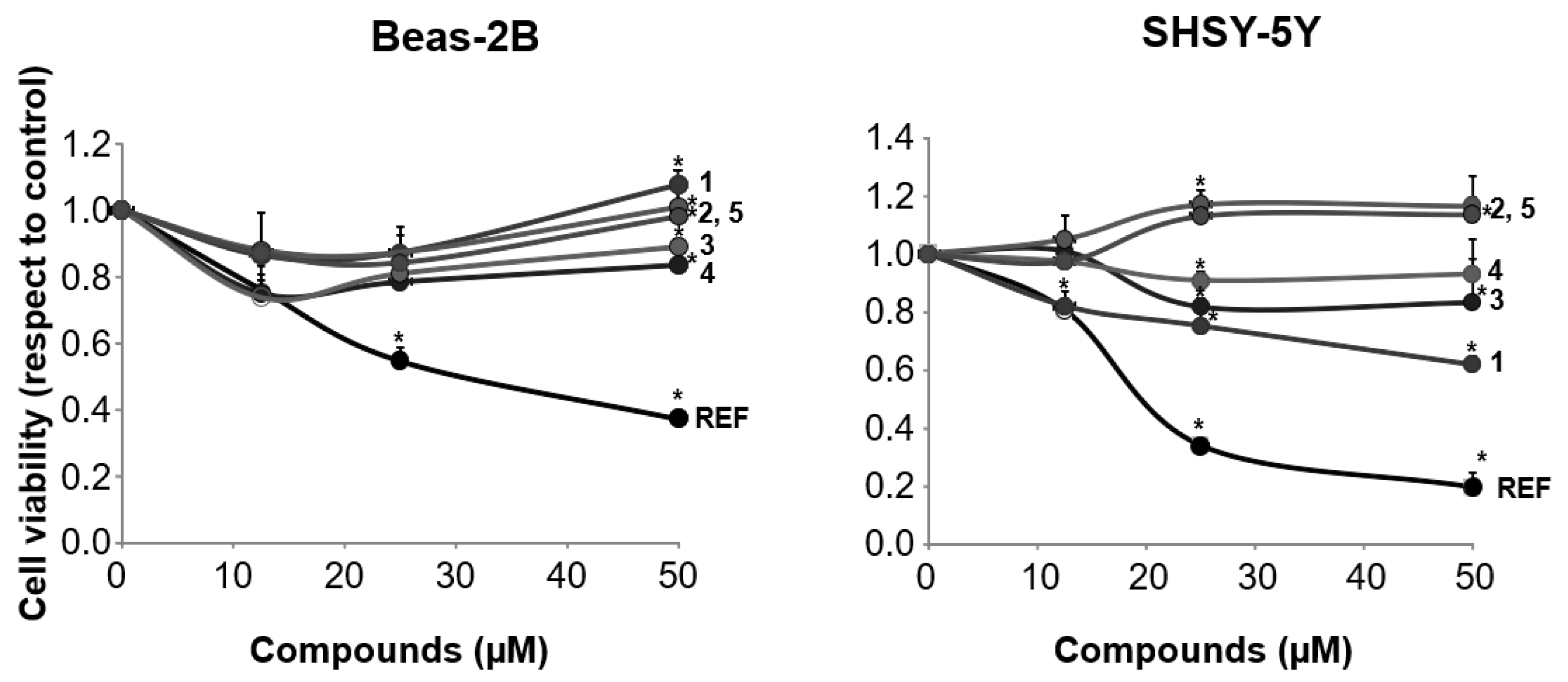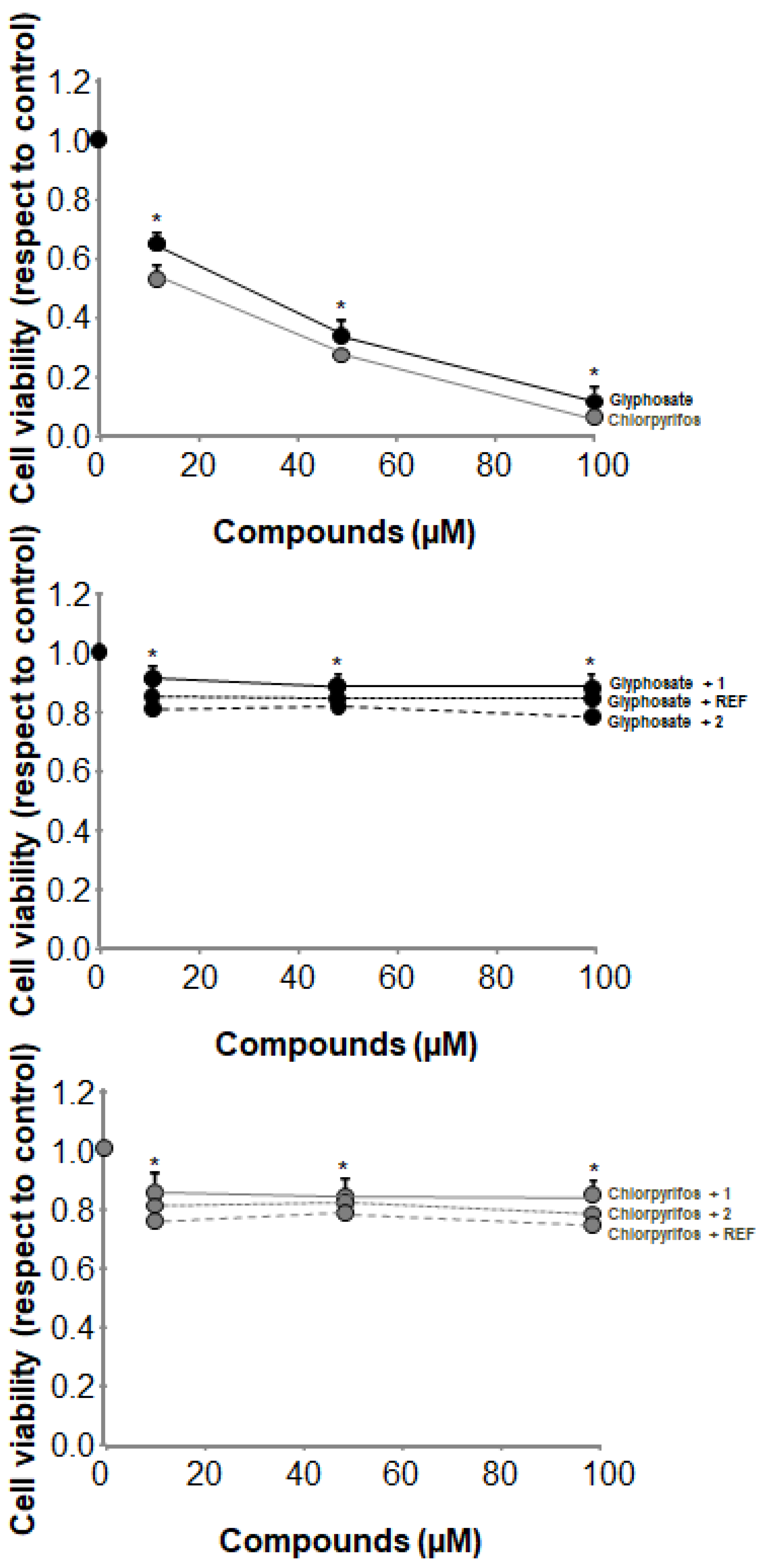Protection of Mitochondrial Potential and Activity by Oxyprenylated Phenylpropanoids
Abstract
:1. Introduction
2. Materials and Methods
2.1. Chemistry
2.2. Analysis of Antioxidant Capacity by the ORAC Assay
2.3. Cell Viability
2.4. Mitochondrial Destabilization
2.5. Statistical Analysis
3. Results
4. Discussion
5. Conclusions
Author Contributions
Funding
Institutional Review Board Statement
Informed Consent Statement
Data Availability Statement
Conflicts of Interest
References
- Fiorito, S.; Preziuso, F.; Sharifi-Rad, M.; Marchetti, L.; Epifano, F.; Genovese, S. Auraptene and umbelliprenin: A review on their latest literature acquisitions. Phytochem. Rev. 2022, 21, 317–322. [Google Scholar] [CrossRef]
- Preziuso, F.; Genovese, S.; Marchetti, L.; Sharifi-Rad, M.; Palumbo, L.; Epifano, F.; Fiorito, S. 7-Isopentenyloxycoumarin: What is new across the last decade. Molecules 2020, 25, 5923. [Google Scholar] [CrossRef] [PubMed]
- Faraone, I.; Russo, D.; Genovese, S.; Milella, L.; Monné, M.; Epifano, F.; Fiorito, S. Screening of in vitro and in silico α-amilase, α-glucosidase, and lipase inhibitory activity of oxyprenylated natural compounds and semisynthetic derivatives. Phytochemistry 2021, 187, 112781. [Google Scholar] [CrossRef] [PubMed]
- Curini, M.; Genovese, S.; Menghini, L.; Marcotullio, M.C.; Epifano, F. Phytochemistry and pharmacology of Boronia pinnata Sm. Nat. Prod. Commun. 2008, 3, 2145–2150. [Google Scholar]
- Epifano, F.; Fiorito, S.; Taddeo, V.A.; Genovese, S. 4′-Geranyloxyferulic acid: An overview of its potentialities as an anti-cancer and anti-inflammatory agent. Phytochem. Rev. 2015, 14, 607–612. [Google Scholar] [CrossRef]
- Fiorito, S.; Preziuso, F.; Epifano, F.; Scotti, l.; Bucciarelli, T.; Taddeo, V.A.; Genovese, S. Novel biologically active principles from spinach, goji and quinoa. Food Chem. 2019, 276, 262–265. [Google Scholar] [CrossRef]
- Genovese, S.; Taddeo, V.A.; Fiorito, S.; Epifano, F. Quantification of 4′-geranyloxyferulic acid (GOFA) in honey samples of different origin by validated RP-HPLC-UV method. J. Pharm. Biomed. Anal. 2016, 117, 577–580. [Google Scholar] [CrossRef]
- Epifano, F.; Genovese, S.; Miller, R.; Majumdar, A.P.N. Auraptene and its effects on the re-emergence of colon cancer stem cells. Phytother. Res. 2013, 27, 784–786. [Google Scholar] [CrossRef] [PubMed] [Green Version]
- Tanaka, T.; de Azevedo, M.B.; Durán, N.; Alderete, J.B.; Epifano, F.; Genovese, S.; Tanaka, M.; Tanaka, T.; Curini, M. Colorectal cancer chemoprevention by 2 β-cyclodextrin inclusion compounds of auraptene and 4′-geranyloxyferulic acid. Int. J. Cancer 2010, 126, 830–840. [Google Scholar] [CrossRef]
- Shimizu, M.; Kochi, T.; Shirakami, Y.; Genovese, S.; Epifano, F.; Fiorito, S.; Mori, T.; Tanaka, T.; Moriwaki, H. A newly synthesized compound, 4′-geranyloxyferulic acid–N(omega)-nitro-L-arginine methyl ester suppresses inflammation associated colorectal carcinogenesis in male mice. Int. J. Cancer 2014, 135, 774–785. [Google Scholar] [CrossRef]
- Fiorito, S.; Epifano, F.; Palumbo, L.; Genovese, S. A novel auraptene-enriched Citrus peels blend with enhanced antioxidant activity. Plants Food Hum. Nutr. 2021, 76, 397–398. [Google Scholar] [CrossRef] [PubMed]
- Genovese, S.; Fiorito, S.; Epifano, F.; Taddeo, V.A. A novel class of emerging anticancer compounds: Oxyprenylated secondary metabolites from plants and fungi. Curr. Med. Chem. 2015, 22, 3426–3433. [Google Scholar] [CrossRef]
- Epifano, F.; Molinaro, G.; Genovese, S.; Teke Ngomba, R.; Nicoletti, F.; Curini, M. Neuroprotective effect of prenyloxycoumarins from edible vegetables. Neurosci. Lett. 2008, 443, 57–60. [Google Scholar] [CrossRef]
- Okuyama, S.; Semba, T.; Toyoda, N.; Epifano, F.; Genovese, S.; Fiorito, S.; Taddeo, V.A.; Sawamoto, A.; Nakajima, M.; Furukawa, Y. Auraptene and other prenyloxyphenylpropanoids suppress microglial activation and dopaminergic neuronal cell death in a lipopolysaccharide-induced model of Parkinson’s disease. Int. J. Mol. Sci. 2016, 17, 1716. [Google Scholar] [CrossRef] [PubMed] [Green Version]
- Galluzzi, S.; Zanardini, R.; Ferrari, C.; Gipponi, S.; Passeggia, I.; Rampini, M.; Sgrò, G.; Genovese, S.; Fiorito, S.; Palumbo, L.; et al. Cognitive and biological effects of Citrus phytochemicals in subjective cognitive decline: A 36-week, randomized, placebo-controlled trial. Nutr. J. 2022, 21, 64. [Google Scholar] [CrossRef]
- Genovese, S.; Curini, M.; Gresele, P.; Corazzi, T.; Epifano, F. Inhibition of COX-1 activity and COX-2 expression by 3-(4′-geranyloxy-3′-methoxyphenyl)-2-trans propenoic acid and its semi-synthetic derivatives. Bioorg. Med. Chem. Lett. 2011, 21, 5995–5998. [Google Scholar] [CrossRef] [PubMed]
- Genovese, S.; Epifano, F.; Fiorito, S.; Curini, M.; Marrelli, M.; Menichini, F.; Conforti, F. Conjugation of L-NAME to prenyloxycinnamic acids improves its inhibitory effects on nitric oxide production. Bioorg. Med. Chem. Lett. 2013, 23, 2933–2935. [Google Scholar] [CrossRef] [PubMed]
- Vu, D.L.; Zhao, L.; Epifano, F.; Genovese, S.; Grenier, D. Anti-inflammatory and wound healing potential of Citrus auraptene. J. Med. Food 2013, 16, 961–964. [Google Scholar]
- Epifano, F.; Genovese, S.; Fiorito, S.; Della Loggia, R.; Tubaro, A.; Sosa, S. In vivo anti-inflammatory activity of some naturally occurring O- and N-prenyl secondary metabolites. Nat. Prod. Commun. 2014, 9, 85–86. [Google Scholar] [CrossRef] [PubMed] [Green Version]
- Azelmat, J.; Fiorito, S.; Taddeo, V.A.; Genovese, S.; Epifano, F.; Grenier, D. Synthesis and evaluation of antibacterial and anti-inflammatory properties of naturally occurring coumarins. Phytochem. Lett. 2015, 13, 399–405. [Google Scholar] [CrossRef]
- Genovese, S.; Fiorito, S.; Taddeo, V.A.; Epifano, F.; Paciotti, R.; Coletti, C.; Franceschelli, S.; Speranza, L.; Ferrone, A.; Felaco, M.; et al. Effects of geranyloxycinnamic acids on COX-2 and iNOS functionalities in LPS-stimulated U937 mononuclear cells. Chem. Sel. 2016, 1, 5479–5486. [Google Scholar]
- Genovese, S.; Taddeo, V.A.; Fiorito, S.; Epifano, F.; Marrelli, M.; Conforti, F. Inhibition of nitric oxide production by natural oxyprenylated coumarins and alkaloids in Raw 264.7 cells. Phytochem. Lett. 2017, 20, 181–185. [Google Scholar] [CrossRef]
- Fiorito, S.; Epifano, F.; Taddeo, V.A.; Genovese, S. Recent acquisitions on oxyprenylated secondary metabolites as anti-inflammatory agents. Eur. J. Med. Chem. 2018, 153, 116–122. [Google Scholar] [CrossRef] [PubMed]
- Touati, E.; Michel, V.; Correia, M.; Menghini, L.; Genovese, S.; Curini, M.; Epifano, F. Boropinic acid, a novel inhibitor of Helicobacter pylori stomach colonization. J. Antimicrob. Chemother. 2009, 64, 210–211. [Google Scholar] [CrossRef] [PubMed]
- Messier, C.; Epifano, F.; Genovese, S.; Grenier, D. Inhibition of Candida albicans biofilm formation and yeast-hyphal transition by 4-hydroxycordoin. Phytomedicine 2011, 18, 380–383. [Google Scholar] [CrossRef]
- Bonifait, L.; Marquis, A.; Genovese, S.; Epifano, F.; Grenier, D. Synthesis and antimicrobial activity of geranyloxy- and farnesyloxyacetophenone derivatives against oral pathogens. Fitoterapia 2012, 83, 996–999. [Google Scholar] [CrossRef]
- Santos, J.; Marquis, A.; Epifano, F.; Genovese, S.; Curini, M.; Grenier, D. Collinin reduces Porphyromonas gingivalis growth and collagenase activity and inhibits the lipopolysaccharide-induced macrophage inflammatory response and osteoclast differentiation and function. J. Periodont. 2013, 84, 704–711. [Google Scholar] [CrossRef]
- Di Giulio, M.; Genovese, S.; Fiorito, S.; Epifano, F.; Nostro, A.; Cellini, L. Antimicrobial evaluation of selected Naturally occurring oxyprenylated secondary metabolites. Nat. Prod. Res. 2016, 30, 1870–1874. [Google Scholar] [CrossRef]
- Genovese, S.; Foreman, J.E.; Borland, M.G.; Epifano, F.; Gonzalez, F.J.; Curini, M.; Peters, J.M. A natural propenoic acid derivative activates peroxisome proliferator-activated receptor-β/δ (PPARβ/δ). Life Sci. 2010, 86, 493–498. [Google Scholar] [CrossRef] [Green Version]
- Genovese, S.; Epifano, F.; Curini, M.; Menger, D.; Zembruski, N.C.L.; Weiss, J. In vitro effects of natural prenyloxycinnamic acids on human cytochrome P450 isozyme activity and expression. Phytomedicine 2011, 18, 586–591. [Google Scholar] [CrossRef]
- Genovese, S.; Ashida, H.; Yamashita, Y.; Nakgano, T.; Ikeda, M.; Daishi, S.; Epifano, F.; Taddeo, V.A.; Fiorito, S. The interaction of auraptene and other oxyprenylated phenylpropanoids with glucose transporter type 4. Phytomedicine 2017, 32C, 74–79. [Google Scholar] [CrossRef] [PubMed]
- Fiorito, S.; Epifano, F.; Marchetti, L.; Palumbo, L.; Erdogan Orhan, I.; Sharifi Rad, M.; Genovese, S. Oxyprenylated secondary metabolites as modulators of lipid and sugar metabolism. Curr. Top. Med. Chem. 2022, 22, 189–198. [Google Scholar] [CrossRef]
- Fiorito, S.; Epifano, F.; Preziuso, F.; Cacciatore, I.; di Stefano, A.; Taddeo, V.A.; de Medina, P.; Genovese, S. Natural oxyprenylated coumarins are modulators of melanogenesis. Eur. J. Med. Chem. 2018, 152, 274–282. [Google Scholar] [CrossRef] [PubMed]
- Murphy, M.P.; Hartley, R.C. Mitochondria as therapeutic target for common pathologies. Nat. Rev. Drug Discov. 2018, 17, 865–886. [Google Scholar] [CrossRef] [PubMed] [Green Version]
- Cho, H.; Cho, Y.Y.; Shim, M.S.; Lee, J.Y.; Lee, H.S.; Kang, H.C. Mitochondria-targeted drug delivery in cancers. Biochim. Biophys. Acta 2020, 1866, 165808. [Google Scholar] [CrossRef] [PubMed]
- Genovese, S.; Epifano, F.; de Medina, P.; Caron, N.; Rives, A.; Poirot, M.; Silvente Poirot, S.; Fiorito, S. Natural and semisynthetic oxyprenylated aromatic compounds as stimulators or inhibitors of melanogenesis. Bioorg. Chem. 2019, 87, 181–190. [Google Scholar] [CrossRef] [PubMed]
- Fiorito, S.; Epifano, F.; Preziuso, F.; Taddeo, V.A.; Genovese, S. Biomolecular targets of oxyprenylated phenylpropanoids and polyketides. Prog. Chem. Org. Nat. Prod. 2019, 108, 143–205. [Google Scholar]
- Bruyere, C.; Genovese, S.; Lallemand, B.; Ionescu-Motatu, A.; Curini, M.; Kiss, R.; Epifano, F. Growth inhibitory activities of oxyprenylated and non-prenylated naturally occurring phenylpropanoids in cancer cell lines. Bioorg. Med. Chem. Lett. 2011, 21, 4173–4178. [Google Scholar] [CrossRef]
- Bradford, M. A rapid and sensitive method for the quantification of microgram quantities of protein utilizing the principle of protein-dye binding. Anal. Biochem. 1976, 72, 248–254. [Google Scholar] [CrossRef]
- Nabekura, T.; Kawasaki, T.; Kato, Y.; Kawai, K.; Fiorito, S.; Epifano, F.; Genovese, S.; Uwai, Y. Citrus auraptene induces drug efflux transporter P-glycoprotein expression in human intestinal cells. Food Funct. 2020, 11, 5017. [Google Scholar] [CrossRef] [PubMed]
- Huang, D.; Ou, B.; Prior, R.L. The chemistry behind antioxidant capacity assays. J. Agric. Food Chem. 2005, 53, 1841–1856. [Google Scholar] [CrossRef] [PubMed]
- Uchendu, C.; Ambali, S.F.; Ayo, J.O. The organophospate, chlorpyrifos, oxidative stress and the role of some antioxidants. A review. Afr. J. Agric. Res. 2012, 7, 2720–2728. [Google Scholar]
- Wang, X.; Lu, Q.; Guo, J.; Ares, I.; Martinez, M.; Martinez-Larranaga, M.R.; Wang, X.; Anadon, A.; Aranzazu Martienz, A. Oxidative stress and metabolism: A mechanistic insight for glyphosate toxicity. Ann. Rev. Pharmacol. Toxicol. 2022, 62, 617–639. [Google Scholar] [CrossRef] [PubMed]
- Bailey, D.C.; Todt, C.E.; Burchfield, S.L.; Pressley, A.S.; Denney, R.D.; Snapp, I.B.; Negga, R.; Traynor, W.L.; Fitsanakis, V.A. Chronic exposure to a glyphosate-containing pesticide leads to mitochondrial dysfunction and increased reactive oxygen species production in Caenorhabditis elegans. Environ. Pharmacol. Toxicol. 2018, 57, 47–52. [Google Scholar] [CrossRef]
- Chiapella, G.; Flores-Martin, J.; Ridano, M.E.; Reyna, L.; Magnarelli de Potas, G.; Panzetta-Dutari, G.M.; Genti-Raimondi, S. The organophosphate chlorpyrifos disturbs redox balance and triggers antioxidant defense mechanisms in JEG-3 cells. Placenta 2013, 34, 792–798. [Google Scholar] [CrossRef]
- Fiorito, S.; Palumbo, L.; Epifano, F.; Collevecchio, C.; Cardellini, F.; Bastianini, M.; Spogli, R.; Genovese, S. An easy way for the hydrolysis, pre-concentration, and chemical stabilization of crocetin from saffron powder. Food Chem. 2022, 377, 132040. [Google Scholar] [CrossRef] [PubMed]
- Charmforoshan, E.; Karimi, E.; Oskoueian, E.; Iranshahi, M. Antibacterial, antioxidant and melanogenesis inhibitory activity of auraptene, a coumarin from Ferula szowitsiana root. Nutr. Cancer 2022, 74, 1829–1836. [Google Scholar] [CrossRef]
- De Oliveira, M.R.; Nabavi, S.F.; Manayi, A.; Daglia, M.; Hajheydari, Z.; Nabavi, S.M. Resveratrol and the mitochondria: From triggering the intrinsic apoptotic pathway to inducing mitochondrial biogenesis, a mechanistic view. Biochim. Biophys. Acta 2016, 1860, 727–745. [Google Scholar] [CrossRef]
- Jeong, S.H.; Han, X.H.; Hong, S.S.; Hwang, J.S.; Hwang, J.H.; Lee, D.; Lee, M.K.; Ro, J.S.; Hwang, B.Y. Monoamine oxidase inhibitory coumarins from the aerial parts of Dictamnus albus. Arch. Pharm. Res. 2006, 29, 1119–1124. [Google Scholar] [CrossRef]
- Jun, D.Y.; Kim, J.S.; Park, H.S.; Han, C.R.; Fang, Z.; Woo, M.H.; Rhee, I.K.; Kim, Y.H. Apoptogenic activity of auraptene of Zanthoxylum schinifolium toward human acute leukemia Jurkat T cells is associated with ER stress-mediated caspase 8 activation that stimulates mitochondria-dependent or independent caspase cascade. Carcinogenesis 2007, 28, 1303–1313. [Google Scholar] [CrossRef]
- Jun, L.; Mahdi, F.; Du, L.; Jekabsons, M.B.; Zhou, Y.D.; Nagle, D.G. Semisynthetic studies identify mitochondria poisons from botanical dietary supplements geranyloxycoumarins from Aegle marmelos. Bioorg. Med. Chem. 2013, 21, 1795–1803. [Google Scholar]
- Jang, Y.; Han, J.; Kim, S.J.; Kim, J.; Lee, M.J.; Jeong, S.; Ryu, M.J.; Seo, K.S.; Choi, S.; Shong, M.; et al. Suppression of mitochondrial respiration with auraptene inhibits the progression of renal cell carcinoma: Involvement of HIF-1α degradation. Oncotarget 2015, 10, 38127–38138. [Google Scholar] [CrossRef] [PubMed] [Green Version]
- Jang, Y.; Choo, H.; Lee, M.J.; Han, J.; Kim, S.J.; Ju, X.; Cui, J.; Lee, Y.L.; Ryu, M.J.; Oh, E.S.; et al. Auraptene mitigates Parkinsons’s disease-like behaviour by protectin inhibition of mitochondrial respiration scavenging reactive active species. Int. J. Mol. Sci. 2019, 11, 3409. [Google Scholar] [CrossRef] [PubMed] [Green Version]
- Akashi, S.; Morita, A.; Mochizuki, Y.; Shibuya, F.; Kamer, Y.; Miura, S. Citrus hassaku extract powder increases mitochondrial content and oxidative muscle fibers by upregulation of PGC-1α in skeletal muscle. Nutrients 2021, 13, 497. [Google Scholar] [CrossRef] [PubMed]
- Lee, M.J.; Yang, Y.; Zhu, J.; Namgung, E.; Go, D.; Seo, C.; Ju, X.; Cui, J.; Lee, Y.L.; Kang, H.; et al. Auraptene enhances junction assembly in cerebrovascular endothelial cells by promoting resilience to mitochondrial stress through activation of antioxidant enzymes and mtUPR. Antioxidants 2021, 10, 475. [Google Scholar] [CrossRef]
- Eriguchi, M.; Lida, K.; Ikeda, S.; Osoegawa, M.; Nishioka, K.; Hattori, N.; Nagayama, H.; Hara, H. Parkinsonism relating to intoxication with glyphosate: A case report. Intern. Med. 2019, 58, 1935–1938. [Google Scholar] [CrossRef] [Green Version]
- Ali, S.J.; Ellur, G.; Patel, K.; Sharan, K. Chlorpyrifos exposure induces parkinsonian symptoms and associated bone loss in adult swiss albino mice. Neurotox. Res. 2019, 36, 700–711. [Google Scholar] [CrossRef]






Disclaimer/Publisher’s Note: The statements, opinions and data contained in all publications are solely those of the individual author(s) and contributor(s) and not of MDPI and/or the editor(s). MDPI and/or the editor(s) disclaim responsibility for any injury to people or property resulting from any ideas, methods, instructions or products referred to in the content. |
© 2023 by the authors. Licensee MDPI, Basel, Switzerland. This article is an open access article distributed under the terms and conditions of the Creative Commons Attribution (CC BY) license (https://creativecommons.org/licenses/by/4.0/).
Share and Cite
Epifano, F.; Genovese, S.; Palumbo, L.; Collevecchio, C.; Fiorito, S. Protection of Mitochondrial Potential and Activity by Oxyprenylated Phenylpropanoids. Antioxidants 2023, 12, 259. https://doi.org/10.3390/antiox12020259
Epifano F, Genovese S, Palumbo L, Collevecchio C, Fiorito S. Protection of Mitochondrial Potential and Activity by Oxyprenylated Phenylpropanoids. Antioxidants. 2023; 12(2):259. https://doi.org/10.3390/antiox12020259
Chicago/Turabian StyleEpifano, Francesco, Salvatore Genovese, Lucia Palumbo, Chiara Collevecchio, and Serena Fiorito. 2023. "Protection of Mitochondrial Potential and Activity by Oxyprenylated Phenylpropanoids" Antioxidants 12, no. 2: 259. https://doi.org/10.3390/antiox12020259





